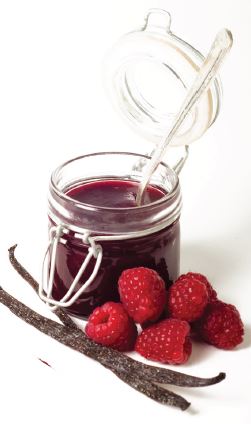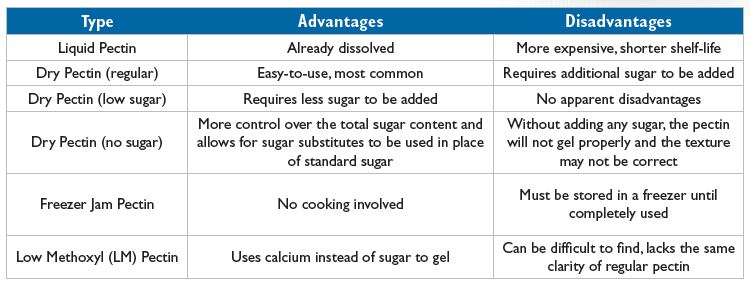 Pectin is an interesting little ingredient. From simple jams and jellies, to high-end pastry and everything in between, pectin allows for fruit-based desserts and dessert components to have that perfect gel texture. The name sounds like something you would find on the periodic table – though not scientific, pastry chefs would agree that it is an important element in many successful dishes.
Pectin is an interesting little ingredient. From simple jams and jellies, to high-end pastry and everything in between, pectin allows for fruit-based desserts and dessert components to have that perfect gel texture. The name sounds like something you would find on the periodic table – though not scientific, pastry chefs would agree that it is an important element in many successful dishes.
What Is Pectin?
Pectin is a naturally occurring, water-soluble fiber and gelling agent that can be found in most fruits and plants. The official definition of pectin, according to Merriam-Webster, is “a substance in some fruits that makes fruit jellies thick when the fruit is cooked.” Pectin comes in many forms such as powder, liquid and sheets. However, BakingBites.com suggests that fruits with high pectin content, such as apples, oranges, berries and plums, can be used as a substitute for these commercial forms. Commercial pectin, sold in grocery stores and markets, is commonly made with extracted pectin from apples or citrus peels.
According to FoodPreservationMethods.com, pectin occurs in fruit in three forms:
- Protopectin – in hard immature fruits like green apples or the peel of citrus fruits
- Pectin – as the fruit matures protopectin becomes soluble pectin, which is used in making jelly
- Pectic acid – if fruit becomes overripe or a jelly is cooked too long, the pectin converts to pectic acid
There are two different classifications of pectin, high-methoxyl (HM) and low-methoxyl (LM). The HM type is further divided into two types – rapid-set and slow-set. Popular Science’s article “Pectin: Not Just for Jelly,” states, “Rapid-set HM pectin is often used for jellies that have ingredients suspended inside the gel structure, such as chunky marmalades or hot pepper jelly, while slow-set HM pectin is often used for clear jellies like apricot or grape.” LM pectin works well in conjunction with locust bean gum and is often used to produce low- or no-sugar jellies.
How Does It Work?
Pectin comes in many forms and therefore has differences in how each form works. When dealing with the powder form, which is the most common, the powder must be dissolved in water and quickly stirred so that it does not create lumps, which can cause an improper gelling of the mixture. The powder form can also be mixed with other water-soluble powders like sugar or salt and then mixed with the liquid ingredients for easier production. The liquid form of pectin dissolves easily in water and with more consistent results, but does have its own disadvantages. (See Advantages and Disadvantages chart on next page.)
Pectin, whether powder or liquid, requires the ancillary ingredients used in recipes to have high sugar content or else the pectin will not thicken or gel properly. This could also allow yeast and mold to grow in the mixture. The recipe must also contain a certain calcium and acid content which are balanced accordingly, as adding the ingredients later in the process will cause the gelling efficiency of the pectin to decline.
The Difference Between Pectin and Gelatin
Pectin and gelatin have similar applications at a basic level – to create a gel texture; however they differ greatly in other uses and foundations. Pectin is a water-soluble fiber derived from non-animal byproducts, whereas gelatin is a protein derived from animals. This makes it possible to create vegetarian and vegan recipes using pectin, providing the other ingredients are also non-animal byproducts. Some pectin are also unique because of their ability to return to a liquid state if the product is reheated, while gelatin will not. The most significant difference between gelatin and pectin would be how they are used in recipes. Pectin has more specific uses, while gelatin can be used in a wider variety of applications, but does not yield the same results.
What Is Pectin Used For?
Pastry chefs describe pectin as an essential ingredient for enhancing the quality of fruit-based jellies and dessert components because of the smooth texture it creates in the final product. While pectin is used most commonly in jams, jellies, marmalades and desserts, pectin can also be used to stabilize acidic protein drinks, such as yogurt. “Using pectin will also improve the mouth-feel and the pulp stability in juice-based drinks and as a fat substitute in baked goods,” says Colin D. May in Science Direct’s article “Industrial Pectins: Sources, Production And Applications.” May also states that pectin’s applications range from desserts to dairy products, soft drinks and even pharmaceuticals. Pectin can also be found in the medical industry because of the fiber content, which can aid in curing gastrointestinal illnesses.
The Advantages and Disadvantages of Pectin
With all the different uses and types of pectin, it is important to understand the advantages and disadvantages of each, and how it affects the end product. Here is how it all breaks down:
Pectin may have an interesting name, but is a pretty important ingredient when trying to give fruit creations that fresh, smooth texture. Understanding the advantages and disadvantages of the different types as well as how they each affect recipes is important before experimenting. Nevertheless, with so many fruit flavor possibilities and fresh jams and jellies trending, pectin has a solid place in culinary pantries.

